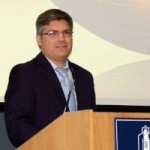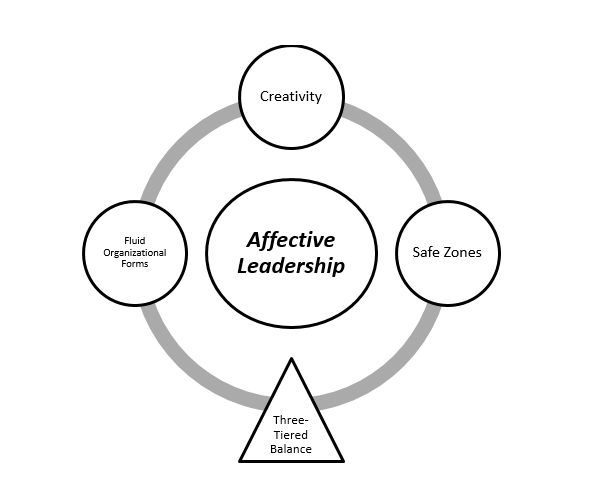by Paul Dannar and Mostafa Sayyadi
The construct of leadership continues to pique the interest of a wide array of practitioners and academics across the globe. In fact, it might be said the desire to gain a better understanding of what leadership really is has overwhelmed the psyche of the majority of society. This continued elevated interest would seem to indicate both a sense of the importance and true nature of leadership as well as a painful recognition that it is lacking or absent in many places. We should indeed be concerned yet hopeful because there is a remedy to what is lacking, and that remedy is affective leadership.
Affective leadership, unlike other approaches, does not seek one answer to the complex issues that face leaders in today’s global, interconnected environment. Instead the affective leadership approach and the model it encapsulates seeks to integrate the better parts of the theories already available, thus creating a model that best fits an organization’s particular set of circumstances. Instead of a static model, we offer a framework that is adaptable, flexible, and sufficiently robust so as to be useful in almost any organizational structure and global situation. The model is powerful because it offers a constructive problem-solving approach to almost any organizational structure or dilemma. How so? you may ask, by ensuring that four interlocking concepts are analyzed, accounted for and ultimately practiced throughout the organization.
- Concept 1: Multiple three-tiered balance is required across the organizations structure and beyond.
- Concept 2: Most organizations dealing in creative and innovative endeavors must be organic and fluid in nature.
- Concept 3: Individual creativity must not only be tolerated, it must be endorsed and used for the betterment of both the individual and the organization.
- Concept 4: There is a need for psychological safe zones throughout the firm.
The model of the interlocking nature of these concepts is depicted as figure 1.
Figure 1. Affective Leadership Model
There is no singular best practice that will solve the many issues facing organizations today; nor, for that matter, is there a leadership model that can even adequately address all the questions deriving from any number of dilemmas. However, the affective leadership approach may be useful in prompting leaders to ensure the four areas discussed in detail; in the previous chapters of this book. Three-tiered balance, fluid organizational structures, creativity and safe zones are considered as they relate to the overarching construct of leadership itself.
So, how is affective leadership different than other leadership models or approaches? Why even ponder affective leadership in the first place? It is one thing to note that the idea of leadership and organizations have changed due to technology and globalization. However, it is another to recognize that these changes cannot be controlled in the traditional sense; they can only be anticipated and then dealt with accordingly. Recognizing patterns and the clues that suggest another change in the external environment come from the creation of fluid organizational structures and the creative capacity of those in that organizational setting. This requires yet another change, and that is the traditional way of viewing work itself. No longer is it useful to work as individuals who occasionally cooperate with one another through meetings. In the new environment in which we find ourselves, work is not just cooperative in nature. Instead, it involves continuous and consistent learning that goes beyond teams and teamwork and is about a fully integrated knowledge creation oriented enterprise. The focus of this enterprise is not what followers can learn from the leader, but what the leader can learn from the professional follower. In other words, successful affective leaders learn from their interactions with people. They become more versatile, expanding their own styles by taking on some behaviors that were at first unnatural. This versatility allows increased awareness and the ability to recognize even more subtle patterns of change. Affective leadership provides the mechanism for both thought and action allowing the leader to think holistically, finding patterns previously hidden in the day-to-day rush for short-term performance improvement, while at the same time creating an action oriented construct for implementing ideas and decisions. Affective leadership changes what leaders do and what leadership is in that it emphasizes organization-wide leadership practices as opposed to leadership by position. Moreover, it underscores that leadership is future focused and that the identification and investigation of developing trends will occupy much of what leaders think about and provide the organization; the expectation must be that it will be learning intensive. Further, affective leadership allows the leader to interpret internal and external information for a wide range of scenarios that might affect the organization and then act upon those developments through the entire business entity rather than in an isolated departmental fashion.
Ultimately, affective leadership describes a different approach to the idea of leadership as a construct. It emphasizes the outcome of leadership as opposed to who is leading or where leadership is coming from by ensuring everyone in the organization is included in the practice of leadership. In reality, affective leadership is impractical if leadership is only practiced by a select few. The affective leadership approach does not accept the traditional view that leadership is active while followership is passive. In fact, without reciprocity of influence among all in the organization, leadership cannot take place. Reciprocity also leads to predictability and stability not in the external environment necessarily, but in the perceived actions of the leader who maintains positive relationships. This is essential because no one person can possibly have all the answers or indeed know all the right questions to ask. Thus, it is crucial that leaders be able to tap into a network of people who can fill in information and knowledge gaps. The age of paradox and uncertainty is upon us; however, reflecting on and then acting on the affective leadership model presented here will ensure organizational leaders are capable of capitalizing on the creativity of all in the organization through the development of fluid organizational structures with the expressed intent of ensuring a quality workplace through the provision of a safe work environment. Affective leadership is vital principally because it influences other’s interpretations and future actions in a manner that creates the impetus for change, and change for the betterment of all is what affective leadership is all about. But it’s not just about change, although being cognizant of and adaptable to our surroundings is certainly critical. The true power of affective leadership is that it is applicable to all the major issues organizations and leaders face daily and it can prepare leaders for issues yet to occur. The primary issues facing leaders are: globalization and the need for leaders to have a global mindset, leadership succession and, yes, change itself. Affective leadership speaks to these various issues, those that keep us up at night, by not addressing the “who” of leadership. There is no one best type of leader. Moreover, one leader cannot be expected to provide the breadth of leadership required to resolve the types of issues organizations face, nor is the focus on the “why” or “when” of leadership. Affective leadership is instead concerned with “how,” not how to lead as an individual, but how to ensure that each of the four pillars in the model address, impact and resolve the issues.


Find a Home-Based Business to Start-Up >>> Hundreds of Business Listings.


















































